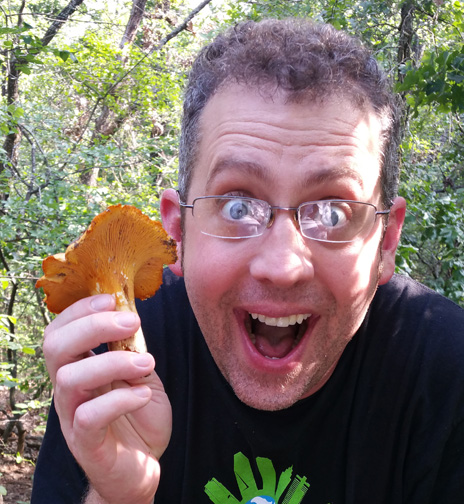
It’s official…Chanterelle season has started. How do I know? Because I found one yesterday. The Chanterelle season in the US normally begins in early June in the southern areas along the Gulf coast. North Texas doesn’t usually start seeing them until later in June, but the recent flooding has brought them early. Northern climes may not see them until early fall, so if you’re wondering when they fruit in your area, a Google search will likely be more helpful than I will. And, as always, Chanterelle season is ENTIRELY dependent upon rainfall. No rain, no mushrooms. The best time to search begins 2-3 days after a heavy rainfall in hot, humid weather, and continuing for 2-3 weeks after that rain, especially if it keeps raining.
Chanterelles are among the easiest wild mushrooms to identify, and they grow in every state but Hawaii. They have NO deadly look-alikes, and the only possible toxic (but not deadly) mushrooms that could be confused with the Chanterelle are easily identified, and distinguished, as well.
Chanterelles do not have gills, like most of the mushrooms we are familiar with. Instead, they have blunt “ridges” that run down the underside of the cap onto the stem, and these ridges distinctly fork or split along their path:
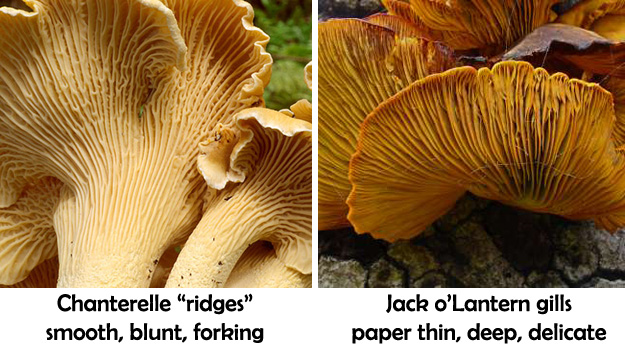 Jack o’Lantern mushrooms (Omphalotus olearius) have paper-thin gills that do not fork. This single identifying characteristic is enough to clearly distinguish between the two. The other rule of thumb to help identify a chanterelle is that chanterelles NEVER grow on wood. Ever. Jack o’Lantern mushrooms always grow on wood, normally in clusters. (However, they may be growing on wood that is buried beneath the surface, so Jack o’Lanterns may sometimes appear to be growing on the ground. Still, they almost always grow in clusters, and Chanterelles almost always grow singly, though there may be several in a small area.)
Jack o’Lantern mushrooms (Omphalotus olearius) have paper-thin gills that do not fork. This single identifying characteristic is enough to clearly distinguish between the two. The other rule of thumb to help identify a chanterelle is that chanterelles NEVER grow on wood. Ever. Jack o’Lantern mushrooms always grow on wood, normally in clusters. (However, they may be growing on wood that is buried beneath the surface, so Jack o’Lanterns may sometimes appear to be growing on the ground. Still, they almost always grow in clusters, and Chanterelles almost always grow singly, though there may be several in a small area.)
Jack o’Lantern mushrooms are not deadly, but they will land you in the bathroom for a couple of unpleasant days, so you certainly don’t want to eat them. (Though, reportedly, they DO taste good!) However, you may want to pick a Jack 0’Lantern if you find one, because their gills glow in the dark! (Thus the name, along with their pumpkin-orange coloration.) Take them into a pitch-black closet and wait there a minute or two for your eyes to adjust, and you’ll see the eerie green glow:
Also, when you break open the cap or stem of a Jack o’Lantern, the flesh inside is the same orange color as the skin. When you break open a Chanterelle, the flesh is pale, creamy white. So there’s really NEVER an excuse to confuse a Jack 0’Lantern mushroom with a Chanterelle, it’s easy as pie to know which is which. Still, some careless folks find an orange-ish mushroom on the ground and, without even looking at it, take it home and cook it up. Don’t be one of those folks.
The only other look-alike for Chanterelles is the False Chanterelle (Hygrophoropsis aurantiaca). Many people eat False Chanterelles, though they don’t taste nearly as good as real Chanterelles, but some folks report adverse reactions to them, so it’s best to avoid them when you find them. Falsies have gills that look halfway between the blunt, shallow ridges of the true Chanterelle, and the thin gills of the Jack o’Lantern:
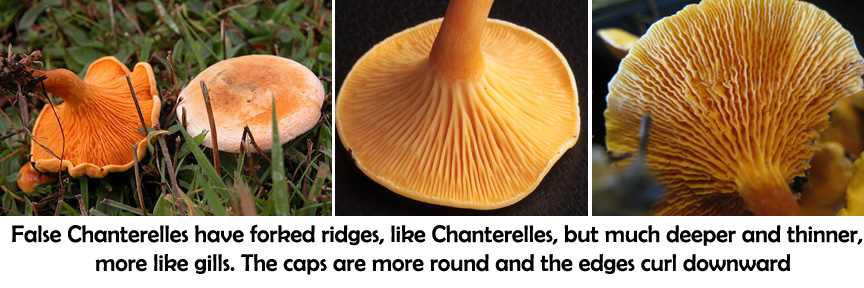 Falsies have forked gills, just like Chanterelle, but they are much deeper and narrower, much more like the gills you’re accustomed to seeing on storebought mushrooms. Also, the edges of the cap turn downward on a Falsie, and a true Chanterelle’s cap edge is wavy, irregular, and thin, especially when mature. Still not sure? Break one in half and smell. A falsie smells like a mushroom. A Chanterelle smells like fruit…kind of like apricots. I’ve never found a false Chanterelle in Texas, but I’ve found PLENTY of true Chanterelles. Conversely, on my fall trip to the Oregon coast last year, I found hundreds of falsies and NO Chanterelles. Go figure!
Falsies have forked gills, just like Chanterelle, but they are much deeper and narrower, much more like the gills you’re accustomed to seeing on storebought mushrooms. Also, the edges of the cap turn downward on a Falsie, and a true Chanterelle’s cap edge is wavy, irregular, and thin, especially when mature. Still not sure? Break one in half and smell. A falsie smells like a mushroom. A Chanterelle smells like fruit…kind of like apricots. I’ve never found a false Chanterelle in Texas, but I’ve found PLENTY of true Chanterelles. Conversely, on my fall trip to the Oregon coast last year, I found hundreds of falsies and NO Chanterelles. Go figure!
Chanterelles come in a variety of colors and sizes. Some are bright red (Cantharellus cinnibarinus), some are small and yellow (Cantharellus minor, or yellowfoot), some are dark blue or black (Craterellus fallax, or black trumpets), but the most common are the Goldens (Cantharellus cibarius), which range in color from yellow to orange, and can grow to a couple of pounds each or larger! This makes all but the black trumpets very easy to spot on the ground as you walk through the woods…they stick out like sore thumbs because of their bright coloration:
Ah, but the all-important question…where do they grow? Chanterelles are mycorrhizal (my-cor-RYE-zul) mushrooms, which means they develop relationships with trees. Mixed hardwood forests are always the best place to find them, around oaks, maple, beech, poplar, and birch. In the Deep South, folks find them beneath blueberry bushes. In mountainous areas, look for white pine and Douglas fir. You’re looking for moist habitat, so focus your search along creekbeds and areas where water flows after a rainfall. Many folks will follow old trails or logging roads through old forests and find them by the bucketful along the edges of the treeline. What is most important, though, is OLD forest. Land that was cut 10 years ago will not have enough healthy, mature trees to support Chanterelles. I do find plenty in forests that have 20-30 year old trees, so you don’t need to look for ANCIENT forests.
Unlike the elusive Morel (which you probably know I’m obsessed with), it can be downright difficult NOT to find Chanterelles if they are in season, there has been enough rain, and you’re looking in the correct type of forest. If there’s enough summer or early fall rain, many people will easily find 10-30 pounds per person in an afternoon of foraging. Here in North Texas, our summers tend to be very dry, so we rarely have an epic Chanterelle OR Morel season, as our rains come in the spring, and then it quickly gets hot and dry. But if June or July sees lots of thunderstorms, the Chanterelles will be out in force! So get ready… In 2017 I picked 20 pounds of Chanterelles in a single afternoon in suburban parks here in Lewisville and Flower Mound.
If you are interested in wild mushroom foraging, you MUST carry at least 2 reliable field guides to cross reference, and NEVER eat ANY mushroom you cannot positively identify, beyond a shadow of a doubt. In many cases, this means taking a spore print. (Guides will explain how.) I highly recommend the books by David Arora, as well as Mushrooming Without Fear, Edible Wild Mushrooms of North America, and National Audubon Society Field Guide to North American Mushrooms. However, a regionally-specific guide is even more indispensable, so look for a field guide to your state or region, as well. Eating the wrong wild mushroom will kill you. But I’ve been foraging for wild mushrooms for years and never been sick once, because I always follow the golden rule: “If in doubt…throw it out!”
Feel free to comment below, and be sure to subscribe to my blog near the upper right corner of this page so you don’t miss a thing!
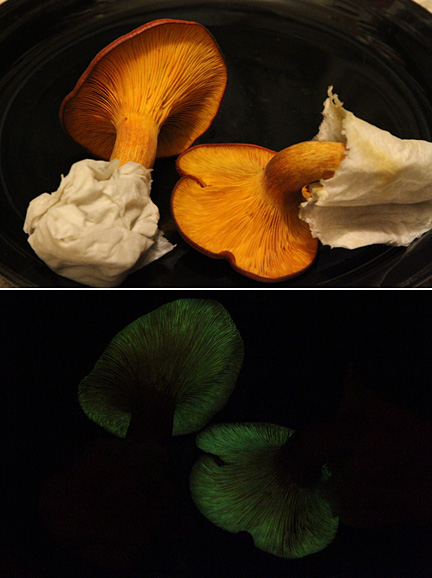
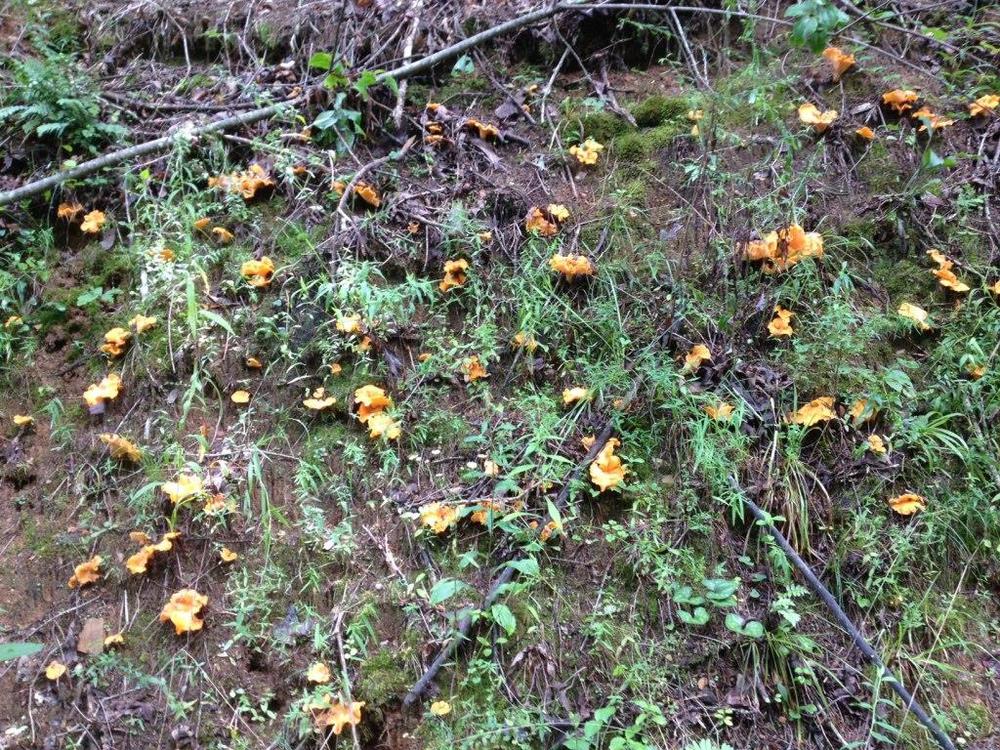
 Morels are tiring on the eyes too cause they blend in with the soil, but May is a nice time to look for them (in dry areas! I know, I am a pansy.) You lucky duck!
Morels are tiring on the eyes too cause they blend in with the soil, but May is a nice time to look for them (in dry areas! I know, I am a pansy.) You lucky duck!

Leave a Reply
You must be logged in to post a comment.